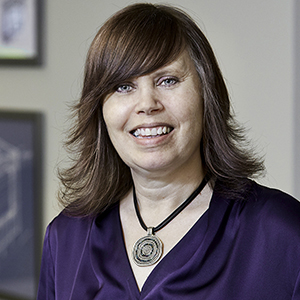Jody Tableporter
Education isn’t all reading textbooks and completing multiple choice exams. The most valuable experiences come when learners are able to step into the shoes of the individuals, situations and careers they are studying. This is authentic learning. One excellent example of this is the structured group exercises in Jody Tableporter’s ABUS 4217: Real Estate: Process and Tools.
Jody Tableporter’s experience spans real estate investment, finance, and city redevelopment. Starting her career with the proprietary investment division (now hedge fund) at Cargill, she worked across the US and Eastern Europe before transitioning into UK urban 'regeneration'. She headed the redevelopment of South London under Mayor Ken Livingstone, and for the current Mayor served on London’s Royal Docks delivery team. She shares her experience in real estate development, finance and large area development in the University of Minnesota’s first two real estate courses ABUS 4217 Real Estate: Process and Tools and ABUS 4218: Real Estate Finance.
When asked about her drive to teach, she replied: "I like to demystify things. I like to present the course in a way that anyone can understand and to encourage more people to enter the field. I entered real-estate development after doing an MBA and had to learn everything on the job. It is not content that is typically covered in a course. It can be a tough industry to get into so I think having some exposure, knowledge and tools can make that easier."
Prospective Property Developers
"The key thing to understand about real estate development is that developers take a lot of risk and are problem solvers; they make decisions in the face of a lot of uncertainty. That underpins the whole course. I want students to stand in the shoes of a real estate developer to experience that risk and uncertainty."
For many years, the Final for Real Estate Development involved ‘pitching’ a project as a team – as if you were a developer within a property development firm. The site was a parking-lot in the North-Loop of Minneapolis. It is a place that is local to many UMN students and is therefore relatively easy to contextualize. Students selected the type of asset they want to deliver (office, hotel, apartment) given local supply/demand and City of Minneapolis area plans and then create:
- a financial ProForma analysis
- a marketing plan with a hoarding (the billboards you see in front of new construction projects)
- a recorded video pitch for the development to a fictitious investment committee
"They have to look where the lot is… What type of real estate asset would work there? Many students chose to develop apartments and therefore needed to understand rental levels and whether a restaurant or gym should go on the bottom floor. They needed to look at the other apartments, stores and restaurants in the area already as well as those planned." All of these questions fed into their financial ProForma analysis. (a financial forward projection that shows expenses, revenue and financing costs for a project so you can determine the internal rate of return) Revenue can come in the form of rent for housing, retail or office space or room rates if you are developing a hotel. Expenses include things like utilities, maintenance, as well as marketing and leasing costs. This internal rate of return is a key metric that helps developers make decisions on the feasibility of one project versus another. Students also need to factor in the local government and the city planner’s ambitions for the city.
Jody is currently updating her Real Estate Development course, a ‘pitch exercise’ similar to that described above now serves as the group project at the midpoint of the course; the Final requires the students to create a business plan (template provided) for their new Real Estate Development Firm. "Talk about stepping into the shoes of a developer…"
Different walks
"A range of students across the University tend to take this course. I get people from our Construction Management program, as well as students from various arts and sciences disciplines, the Business School, the Architecture school… all types of students." This mix creates the opportunity for people from different knowledge backgrounds and disciplines to work together to achieve a common goal. "Often this works to their advantage of the teams… for example: a student from the Carlson School can contribute a bit of finance and spreadsheet knowledge. Those from industry know something about real estate. Other students are just great researchers, thinkers, project managers, presentation makers. Some people have no familiarity with any of these things but they just chip in because they’re thinking they might want to invest in properties in the future. I try to shy away from putting students from similar backgrounds and interests in the same team so they can learn from each other’s relative expertise. It mirrors how real estate projects work…"
"I talk about real estate development like a team sport. It’s not like one person, a lone wolf doing deals. It’s a whole group of people across many disciplines coming together for a project."
The biggest problem with group projects is scheduling. Since students have different academic schedules and this can lead to conflict. For example who does what and who gets the credit. As Jody says "That’s like real life. You have to learn to work with each other’s schedules and skills to do a project and meet a deadline. I try to set an expectation early in the course for team members to hold each other accountable. That way you don’t have instances later in the semester of a group member's lack of contribution harming the final project. It is difficult to do this with a fully online course because I have to take what students say at face value but I try to control this by having students report on team members and their level of contribution. It can be difficult to have students hold each other accountable, but this problem occurs in the real world so it is better to learn to deal with it now."
Change is constant
The course always requires updating; this year the existing series of case studies was feeling a bit dated so I replaced those with the expanded 'pitch' and “business plan” group exercises I referred to earlier. I also created more of a scaffolding of concepts, learnings and tools in the exercises to tie to these two group assignments. What’s the impact? The old exercises involved looking at situations, whereas the new approach puts the students in the driver’s seat both on a project of their choosing and in terms of developing a business plan for their own real estate development business. This will result in more student investment and ownership. "The idea was to develop a more meaningful and authentic experience that threads through the course."
Student Feedback and Tips
"Students are always seeking a meaningful project; the Final was always well received so this expanded approach should go down well. It goes against what I am saying but you still get students that want 'here are your materials and here is your test.' It can sometimes be uncomfortable for students when they have to extend the learning as opposed to answering questions about what they have read. It means having to experience that risk, having to learn to trust your teammates and doing things they might not have done before. But this is where real learning occurs."
When I asked Jody for any tips for other instructors that want to create an assignment like this: "It does take more work, but the advantages over using a ready-made case study is that you can better tailor the project to the course and student abilities, and you can work in some humor as well. And it seems to both be appreciated by students and I get to see a variety of interesting projects as a result."






